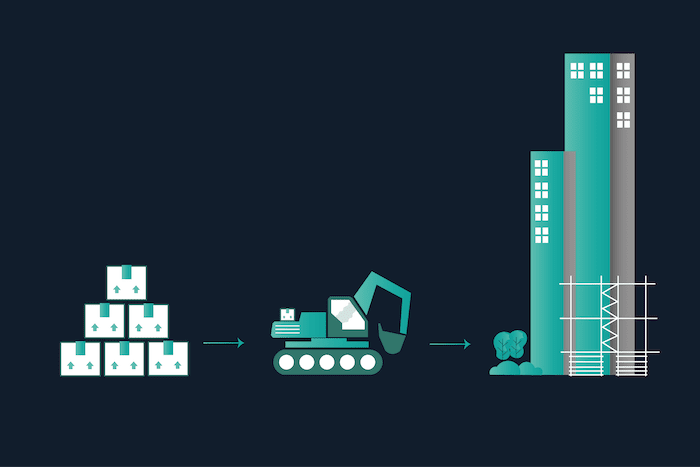According to a survey carried out in May 2021, 47.8% of UK businesses are using more UK suppliers now than pre-Brexit. Why? Procurement is undergoing a rapid transformation, with the effects of the Coronavirus pandemic and the UK’s departure from the EU dictating a requirement for companies to re-evaluate their supply chains, ensuring they are agile and robust enough to ride out the storm. A SAPIO Research survey conducted in March 2021 highlighted that 90% of businesses have faced disruption since the end of the Brexit transition period and 76% had their Brexit response disrupted by Covid-19. The construction industry is a key contributor to the UK economy, representing 6% of GDP, and employs 7% of the UK workforce, so how has one of the largest and most pivotal sectors of industry been impacted by Covid and Brexit and what are the challenges for UK-EU cross border trade?
In this article, with support from BAM, Key Account Manager Natalie Palframan will explore the impact that Brexit and Coronavirus are having on the supply chain.
Raw Materials: Price Increases and Supply Shortages
The Department for Business, Energy and Industrial Strategy reported that China was the single largest source of imports for the UK construction sector in 2018, accounting for £2.83bn of materials. During the pandemic, manufacturing plants in China were forced to close to reduce the spread of the virus and subsequently struggled to keep up with production in the aftermath of the outbreak. This had a detrimental impact on China’s economy with their production accounting for approximately one-quarter of global manufacturing. UK construction companies experienced a knock-on effect as raw materials became increasingly short in supply. As China embarks on an economic recovery strategy, demand for raw materials such as steel, timber, PVC, and chemicals exceeds supply, resulting in economically affluent countries buying up supplies and stock piling materials, which in turn has led to unprecedented price increases. With 71% of contractors facing material supply shortages at the beginning of the year, The Construction Leadership Council (CLC) has forewarned the industry that the situation is likely to get worse, as global demand continues to outweigh production capacity.
To exacerbate the situation, the international shipping crisis coincided with problems faced by UK businesses trading with the EU post-Brexit. A shortage of empty freight containers and bottleneck queues at UK ports, saw shipping costs rise exponentially by over 525%, with the average cost of a container being £1600 in November 2020, compared to a staggering £10,000 in December once the UK left the EEA and entered into the EU-UK Trade and Cooperation Agreement. This placed even greater strain on construction supply chains, as in addition to the shortages and inflated prices, the shipping issues caused supply delays. The congestion at UK ports was an initial result of PPE imports needed to help control the transmission of the virus and stocks arriving as non-essential retail was given the green light to re-open for Christmas trade. However, on-going covid related issues and delays has meant shipping costs have continued to rise, with an estimated 5.5% of all ocean capacity currently waiting outside a port to dock and unload. For UK construction, this compounds the challenges of raw material shortages and delays and further drives up the costs to import them. It is of little surprise therefore that in January, EU imports fell by a record £6.7bn, making a poor recovery the following month, increasing only by £1.2bn. The continued disruption has caused construction supply chain managers to be concerned about keeping projects on track and within budget and has forced them to consider the benefits of a local supply chain.
Brexit Legislation: VAT Reverse Charge
When the UK left the EU, it became a third country for VAT purposes. Companies trading with the UK, excluding Northern Ireland, became subject to the rules of trade with a non-EU country resulting in VAT on imports and exports. The new regulations mean that importers and exporters must have an Economic Operators Registration and Identification (EORI) number for customers and the necessary VAT documentation. Failure to comply with the procedure will cause issues and delays with supply.
Furthermore, on 1st March 2021, the Construction Services Domestic Reverse Charge (CSDRC) rules for VAT came into force. It is the most remarkable change to construction VAT regulations in over half a century. The procurement process in the construction industry has completely changed as a result. The new legislation means customers can charge themselves VAT and pay it directly to HM Revenue and Customs (HMRC), as opposed to the supplier issuing an invoice. The reverse charge has been implemented to prevent suppliers avoiding VAT payments to HMRC. But not only has it caused a level of complexity for accounting; it has put pressure on the cash flow of SMEs who represent a 90% majority of the construction industry’s supply chain. The repercussions of not receiving VAT payments from customers but still having to pay VAT on their purchases can have financially crippling outcomes, particularly in an environment where the cost of materials is rising.
Daniel Billinge, Head of Procurement, BAM, Commented: “BAM values open collaboration with its supply chain. We work hard to maintain strong relationships with suppliers and sub-contractors especially during recent difficult times.
We adapted our processes to the changing market by ensuring sufficient float in procurement programmes to account for extended lead-in periods for low availability products and seeking alternatives. This allows sub-contractors to fix prices with manufacturers and suppliers early, reducing risk, benefitting everyone involved.
We hope the market will settle soon but for the time being we are engaging with all project parties, providing current intelligence available because prices and availability change weekly”.
Workforce: Skills Gap and Labour Shortage
A combination of an ageing workforce and record lows of employment has resulted in a problematic skills shortage within the construction sector. Employees aged 51-60 years of age represent 22% of the labour force, and as they enter retirement, there is growing concern this will lead to a significant loss of skilled professionals. The industry is supported by overseas workers for both skilled and manual roles, with approximately 10% of the workforce comprising of EU nationals. However, since Brexit this number has been in decline. Numbers of EU workers operating on construction sites in London between 2018 and 2020 plummeted from 115,000 to 53,000. From 1st July construction companies employing EU nationals will be expected to check each applicant’s right to work in the UK, lengthening the employment administration process. For EU workers already in UK employment, they will be required to apply for the right to remain under the Government’s EU Settlement Scheme and employers must obtain proof of their settled or pre-settled status. The new immigration system for non-EU citizens and EU citizens who were not working in the UK before 31st December 2020, operates on a points-based method and came into effect at the start of the year.
The Office for National Statistics (ONS) found that construction employment is currently at its lowest since 2013, with 2.17 million people making up the workforce between July and September 2020. This downturn has been ascribed to the persisting Covid issues, so as restrictions continue to lift, employment levels should start to rise and apprenticeship schemes to attract a younger workforce can resume.
The construction industry must adapt and respond quickly to challenges, like those faced by Brexit and Covid, to future proof business and protect the supply chain. Engaging with a professional UK procurement framework provider, like Procure Partnerships who specialise in construction frameworks, can have substantial benefits for construction companies, helping with compliance and navigation through an ever-changing procurement landscape.
Click Here To Download a Procure Partnerships Framework User Guide
Twitter
Linkedin

Natalie Palframan, the Key Account Manager for the North of England at PPF, boasts nearly a decade of invaluable experience within the construction industry. In her dynamic role, Natalie has spent three impactful years at PPF, where her passion lies in closely collaborating with public sector clients across the North, providing expert advice and guidance for their projects.



